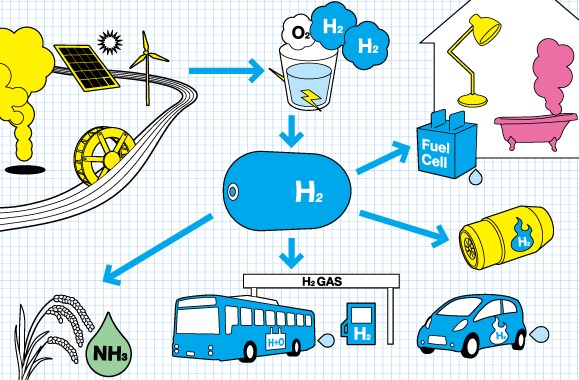Blue hydrogen

|
Contents |
[edit] Introduction
Blue hydrogen is a type of hydrogen fuel. It has been included as part of the first UK hydrogen strategy, which was introduced by the Government in August 2021.
Ref https://www.gov.uk/government/news/uk-government-launches-plan-for-a-world-leading-hydrogen-economy
[edit] Methods of production
There are two primary methods of creating blue hydrogen (H2). One is through the gasification of methane in combination with materials (such as natural gas) and steam. This is referred to as the process of SMR or steam methane reforming.
The other method of blue hydrogen production is through coal gasification. This process results in the generation of greenhouse gases in the form of carbon dioxide, which require capture and storage (also known as sequestration).
Carbon dioxide sequestration is typically achieved through methods of carbon capture and storage (CCS). CCS refers to a range of technologies that capture carbon dioxide emissions and then store them permanently so they do not enter the atmosphere and contribute to climate change.
[edit] Critics of blue hydrogen
Blue hydrogen production has been proposed as part of the UK’s path to a zero carbon future by 2030. Sceptics have voiced concerns, pointing out the method’s continued dependence on fossil fuels which are required in the process. They also doubt that all CO2 emissions can be successfully captured during the production of blue hydrogen through coal gasification.
There is also criticism regarding the environmental consequences associated with methane emissions that are a by product of the SMR process. Due to its ability to trap heat in the atmosphere, methane has been linked to climate change.
On 12 August 2021, Energy Science & Engineering published, ‘How green is blue hydrogen?’ Written by Robert W Howarth of Cornell University and Mark Z Jacobson of Stanford University, the research examines the viability of blue hydrogen which has been called a low emission fuel source.
The researchers undertook “...the first effort in a peer-reviewed paper to examine the lifecycle greenhouse gas emissions of blue hydrogen accounting for emissions of both carbon dioxide and unburned fugitive methane'.
The researchers concluded that 'far from being low carbon, greenhouse gas emissions from the production of blue hydrogen are quite high, particularly due to the release of fugitive methane. For our default assumptions (3.5% emission rate of methane from natural gas and a 20-year global warming potential), total carbon dioxide equivalent emissions for blue hydrogen are only 9% to 12% less than for grey hydrogen. While carbon dioxide emissions are lower, fugitive methane emissions for blue hydrogen are higher than for grey hydrogen because of an increased use of natural gas to power the carbon capture.
'Perhaps surprisingly, the greenhouse gas footprint of blue hydrogen is more than 20% greater than burning natural gas or coal for heat and some 60% greater than burning diesel oil for heat, again with our default assumptions. In a sensitivity analysis in which the methane emission rate from natural gas is reduced to a low value of 1.54%, greenhouse gas emissions from blue hydrogen are still greater than from simply burning natural gas, and are only 18% to 25% less than for grey hydrogen. Our analysis assumes that captured carbon dioxide can be stored indefinitely, an optimistic and unproven assumption. Even if true though, the use of blue hydrogen appears difficult to justify on climate grounds.'
[edit] Related articles on Designing Buildings
- A systems approach to net-zero.
- BSRIA Briefing 2021.
- Carbon capture and storage.
- ECA responds to the UK hydrogen strategy.
- Hydrogen.
- Is hydrogen the heating fuel of the future?
- Planning now for hydrogen
- Sixth carbon budget.
- Smoothing the path to net zero.
[edit] External resources
- HM Government, UK Hydrogen Strategy.
- Robert W Howarth of Cornell University and Mark Z Jacobson, Energy Science & Engineering, ‘How green is blue hydrogen?’
Featured articles and news
Amendment to the GB Energy Bill welcomed by ECA
Move prevents nationally-owned energy company from investing in solar panels produced by modern slavery.
Gregor Harvie argues that AI is state-sanctioned theft of IP.
Heat pumps, vehicle chargers and heating appliances must be sold with smart functionality.
Experimental AI housing target help for councils
Experimental AI could help councils meet housing targets by digitising records.
New-style degrees set for reformed ARB accreditation
Following the ARB Tomorrow's Architects competency outcomes for Architects.
BSRIA Occupant Wellbeing survey BOW
Occupant satisfaction and wellbeing tool inc. physical environment, indoor facilities, functionality and accessibility.
Preserving, waterproofing and decorating buildings.
Many resources for visitors aswell as new features for members.
Using technology to empower communities
The Community data platform; capturing the DNA of a place and fostering participation, for better design.
Heat pump and wind turbine sound calculations for PDRs
MCS publish updated sound calculation standards for permitted development installations.
Homes England creates largest housing-led site in the North
Successful, 34 hectare land acquisition with the residential allocation now completed.
Scottish apprenticeship training proposals
General support although better accountability and transparency is sought.
The history of building regulations
A story of belated action in response to crisis.
Moisture, fire safety and emerging trends in living walls
How wet is your wall?
Current policy explained and newly published consultation by the UK and Welsh Governments.
British architecture 1919–39. Book review.
Conservation of listed prefabs in Moseley.
Energy industry calls for urgent reform.
























